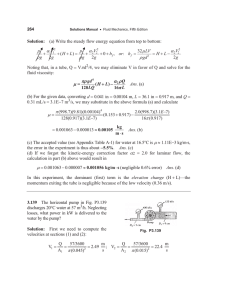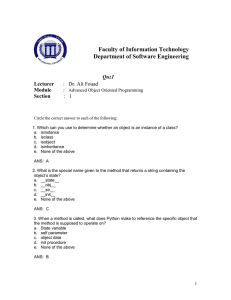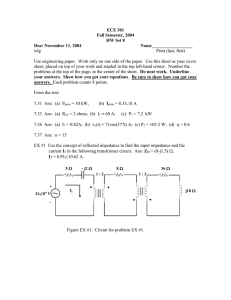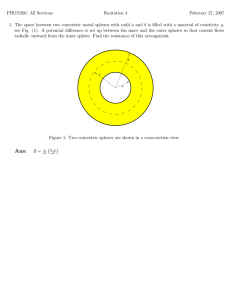Exam2_T112
advertisement
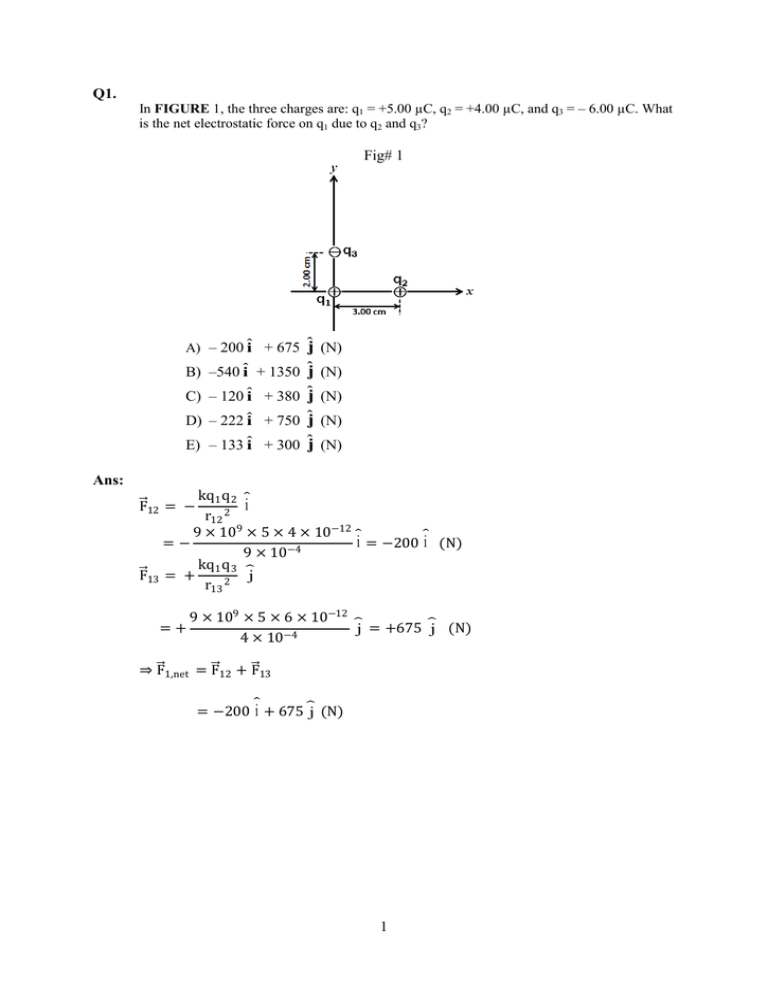
Q1. In FIGURE 1, the three charges are: q1 = +5.00 µC, q2 = +4.00 µC, and q3 = – 6.00 µC. What is the net electrostatic force on q1 due to q2 and q3? Fig# 1 A) – 200 î + 675 ĵ (N) B) –540 î + 1350 ĵ (N) C) – 120 î + 380 ĵ (N) D) – 222 î + 750 ĵ (N) E) – 133 î + 300 ĵ (N) Ans: kq1 q 2 � i r12 2 9 × 109 × 5 × 4 × 10−12 � � i = −200 i (N) =− 9 × 10−4 kq q �⃗13 = + 1 3 �j F r13 2 �F⃗12 = − 9 × 109 × 5 × 6 × 10−12 � =+ j = +675 �j (N) −4 4 × 10 �⃗1,net = F �⃗12 + F �⃗13 ⇒F � = −200 i + 675 �j (N) 1 Q2. Consider three distant spheres with charges Q1i = 1C, Q2i = 2C, and Q3i = 3C. We allow these three charges to touch each other for a short time and then we separate them. The new charges of these spheres become Q1f = q, Q2f = 0.5q, and Q3f = 1.5q. Find the value of q. A) B) C) D) E) 2C 1C 3C 6C 4C Ans: Qi = Q1i + Q2i + Q3i = 6C Qf = Q1f + Q2f + Q3f = 3q Qi = Qf ∶ 3q = 6C ⇒ q = 2C Q3. Particle 1 of charge Q1 = 4Q and particle 2 of charge Q2 = 9Q are fixed as shown in FIGURE 2. At what distance from Q1 along the y-axis will the net electric field due to the two particles be zero? Fig#2 A) 2L/5 B) C) D) E) Ans: 4L/9 2L/3 3L/2 3L/5 �⃗ will be zero at a point between them. Since both particles are positive, E Let �E⃗ be zero at a point that is a distance d from Q1 : kQ1 kQ2 L−d 2 Q2 E1 = E2 : 2 = ⇒ � � = d (L − d)2 Q1 d L−d Q2 L 3 L 5 = � ⇒ −1= ⇒ = d Q1 d 2 d 2 d 2 2L ∴ = ⇒d= L 5 5 2 Q4. An electron is shot (ejected) at an initial speed of 3.0×104 m/s at an angle of 45o relative to the positive x-axis, as shown in FIGURE 3. At time t = 0, the electron enters a region of uniform −6 electric field E = 2.0 × 10 ˆj (N/C). Find the velocity of the electron along y-axis at t = 1.0 s. Ignore gravity. Fig# 3 A) –3.2×105 ĵ m/s B) +3.2×105 ĵ m/s C) –2.5×103 ĵ m/s D) +2.5×103 ĵ m/s E) +3.2×103 ĵ m/s Ans: Fe = ma ⇒ qE = ma ⇒ a = qE m 1.6 × 10−19 × 2.0 × 10−6 = 3.5 × 105 m/s2 9.11 × 10−31 ⇒ a�⃗ = −3.5 × 105 �j (m/s 2 ) ∴a= Vy = Voy − at = (3.0 × 104 ) − (3.5 × 105 × 1.0) = −3.2 × 105 m/s ⇒ �V⃗y = −3.2 × 105 �j m/s 3 Q5. Consider three different electric dipoles placed in the same uniform electric field E, as shown in FIGURE 4, where θ = 60o. Which of these dipoles has (or have) the LOWEST electric potential energy? Fig # 4 A) 2 B) 1 C) 3 D) 1 and 3 E) 2 and 3 Ans: U = −p �⃗. �E⃗ U1 = − qd 1 qdE . E. = − 2 2 4 1 qdE U2 = −qd. E. = − 2 2 d 1 qdE U3 = −q. . E. = − 2 2 4 4 Q6. A cube of 2.0 m edge is placed in a uniform field given by E = 2.0ˆi + 1.0ˆj (N/C). The flux of the electric field through the face (F) perpendicular to the y- axis (see FIGURE 5) is Fig# 5 A) 4.0 N.m2/C B) 8.0 N.m2/C C) 12 N.m2/C D) 48 N.m2/C E) zero Ans: �⃗ = �2.0 �i + 1.0 �j � . (4.0 �j ) ���⃗ A ϕ = E. = 4.0 N. m2 /C Q7. In FIGURE 6, a charge q is placed at the common center of two hemispheres A and B. The flux of the electric field through hemisphere B is Fig# 6 A) equal to the flux through hemisphere A B) double the flux through hemisphere A C) four times the flux through hemisphere A D) zero E) half the flux through hemisphere A Ans: In both surfaces: q enc = q 5 Q8. Consider three infinite non-conducting sheets with uniform charge densities (–σ, +2σ, +3σ), as shown in cross section in FIGURE 7. The electric field between plates A and B is given by Fig# 7 A) B) C) D) E) Ans: EA = EB = EC = 3σ εo 6σ εo 3σ εo 6σ εo σ εo to the left to the left to the right to the right to the right σ ⟶ to the left 2ε0 2σ ⟶ to the left 2ε0 3σ ⟶ to the left 2ε0 ∴ Enet = EA + EB + EC = σ + 2σ + 3σ 3σ = ⟶ to the left 2E0 ε0 Q9. 6 Two infinite wires are charged with uniform and opposite linear charge densities +λ and –λ, where λ = 1.00 nC/m, as shown in FIGURE 8. The flux of the electric field through the Gaussian cylindrical surface (S) is Fig# 8 A) +2.26 N.m2/C B) –2.26 N.m2/C C) +113 N.m2/C D) –113 N.m2/C E) zero Ans: Only + λ contributes to the flux q enc = λh = 1.00 × 10−9 × 2.00 × 10−2 = 2.00 × 10−11 C ϕ= 2.00 × 10−11 q enc = = +2.26 N. m2 /C ϵ0 8.85 × 10−12 7 Q10. A point charge q = –1.0×10-10 C is placed at the center of a spherical conducting shell that has a total charge Q = 5.0×10-10 C, as shown in FIGURE 9. The outer surface has radius R2 = 10 cm. The charge density on the external surface is equal to: Fig# 10 A) +3.2 nC/m2 B) –3.2 nC/m2 C) +4.0 nC/m2 D) +0.80 nC/m2 E) –0.80 nC/m2 Ans: q in = −q = +1.0 × 10−10 C Q = q in + q out ∴ q out = Q − q in = 5.0 × 10−10 − 1.0 × 10−10 σout = = +4.0 × 10−10 C q out 4πR 2 2 4.0 × 10−10 = + = +3.2 × 10−9 C/m2 = +3.2 nC/m2 4π × 0.01 Q11. A uniform electric field of magnitude 325 V/m is directed in the negative y direction. The coordinates of point A are (–0.200, –0.300) m, and those of point B are (0.400, 0.500) m. Calculate the electric potential difference VB – VA. A) B) C) D) E) Ans: +260 V –260 V –195 V +195 V +325 V �⃗. ∆r⃗ ∆V = −E �⃗. (r⃗B − r⃗A ) VB − VA = −E = 325ĵ. (0.6𝑖𝑖̂ + 0.8ĵ) = +260 V 8 Q12. An electron is released from rest at the origin in a uniform electric field that points in the positive x direction and has a magnitude of 850 N/C. What is the change in the electric potential energy of the electron-field system when the electron moves a distance of 2.5 m? A) B) C) D) E) –3.4 × 10-16 J +3.4 × 10-16 J –1.4 × 10-16 J +1.4 × 10-16 J –5.4 × 10-16 J Ans: The electron will move opposite to the field ⇒ ∆r⃗ = −2.5 𝑖𝑖⃗ (m) �⃗. ∆r⃗� = −qE �⃗. ∆r⃗ ∆u = q. ∆V = q�−E = −(−1.6 × 10−19 ). ( 850𝑖𝑖⃗ ). (−2.5𝑖𝑖⃗ ) Q13. = −3.4 × 10−16 J Two point charges (+q and – q) are placed as shown in FIGURE 10. Consider the points 1, 2, 3, and 4 that are shown on the figure. At which point is the net electric potential HIGHEST? Take V = 0 at infinity. Fig#10 A) 4 B) 3 C) 2 D) 1 E) All points have the same potential Ans: 𝑉𝑉1 = 𝑉𝑉2 = 0 Point 4 is closer to the positive charge. ⇒ 𝑉𝑉4 > 𝑉𝑉3 9 Q14. Four point charges are placed at the corners of a square, as shown in FIGURE 11. The magnitudes of the charges are equal. What is the electric potential energy of the system? Fig#11 4 3 r A) zero B) +5.4 kQ2/d C) +2.6 kQ2/d D) –2.6 kQ2/d E) +0.71 kQ2/d Ans: U = 𝑘𝑘 �− = 𝑧𝑧𝑧𝑧𝑧𝑧𝑧𝑧 2 1 𝑄𝑄 2 𝑄𝑄 2 𝑄𝑄 2 𝑄𝑄 2 𝑄𝑄 2 𝑄𝑄 2 + + − − + � 𝑑𝑑 𝑟𝑟 𝑑𝑑 𝑑𝑑 𝑟𝑟 𝑑𝑑 Q15. In a certain region of space, the electric potential is given by: V = 2.0 xyz2, where V is in volts, and x, y, and z are in meters. What is the magnitude of the electric field at the point with position vector ( 2.0ˆi − 2.0ˆj + 4.0kˆ )? A) 111 V/m B) 90.8 V/m C) 16.1 V/m D) 743 V/m E) 571 V/m Ans: Ex = − Ey = − Ez = − ∂V V = −2yz 2 → Exp = (−2)(−2)(16) = +64 ∂x m ∂V = −2xz 2 → Eyp = (−2)(2)(16) = −64 V/m ∂y ∂V = −4xyz → Ezp = (−4)(2)(2)(4) = −64 V/m ∂z E = (Ex 2 + Ey 2 + Ez 2 )1/2 = 111 V/m 10 Q16. The electric potential immediately outside a charged conducting sphere is 200 V, and 10 cm farther from the surface of the sphere the potential is 150 V. What is the charge on the sphere? A) B) C) D) E) Ans: 6.7 nC 0.95 nC 1.3 nC 8.9 nC 5.4 nC V2 kQ R R kQ = . = R � V1 R + 0.1 kQ R + 0.1 kQ 150 R 3 R V2 = = → = R + 0.1 200 R + 0.1 4 R + 0.1 V1 = 3R + 0.3 = 4R → R = 0.3 m ⇒Q= V1 . R 200 × 0.3 = = 6.7 nC k 9 × 109 Q17. FIGURE 12 shows a combination of four capacitors C1 = C3 = 8.0 µF and C2 = C4 = 6.0 µF connected to a 12-V battery. Calculate the charge on capacitor C1. Fig# 12 A) B) C) D) E) 36 µC 18 µC 12 µC 24 µC 30 µC Ans: C24 = C2 + C4 = 12μF 1 1 1 1 1 1 1 = + + = + + Ceq C1 C3 C24 8 8 12 = 3 3 2 8 + + = 24 24 24 24 ⇒ Ceq = 3.0 μF Qeq = Ceq . V = 3.0 × 12 = 36 V = Q1 = Q3 = Q24 11 Q18. A 20-V battery is connected to a series of N capacitors, each of capacitance 4.0 µF. If the total energy stored in the capacitors is 50 µJ, what is N? A) B) C) D) E) 16 12 4 10 8 Ans: Series identical capacitance: = ⇒ Ceq = C N 1 1 1 1 N = + + + . . .= Ceq C C C C 1 CV 2 CV 2 4.0 × 10−6 × 400 2 U = Ceq V = →N= = = 16 2 × 50 × 10−6 2 2N 2U Q19. A 2-µF and a 1-µF capacitor are connected in series and charged by a battery. They store charges P and Q, respectively. When disconnected and charged separately using the same battery, they have charges R and S, respectively. Then: A) B) C) D) E) R>S>P=Q P>Q>R=S R>P>S=Q R>Q>S=P S>R>P=Q Ans: Series: P = Q Charge on R is more because CR > Cs 12 Q20. A 2.0-nF parallel plate capacitor is charged using a 12-V battery. The battery is removed and a dielectric of dielectric constant κ = 3.5 is inserted, filling completely the space between the plates of the capacitor. What is the energy stored in the capacitor after inserting the dielectric? A) B) C) D) E) 4.1 × 10-8 J 5.0 × 10-5 J 1.4 × 10-7 J 2.4 × 10-8 J 1.0 × 10-6 J Ans: Qi = Ci . Vi = Qf Qf 2 1 2 2 1 Ci Vi 2 = Ci Vi . = Uf = 2 kCi 2Cf 2k = 2.0 × 10−9 × 144 = 4.1 × 10−8 J 2 × 3.5 13
